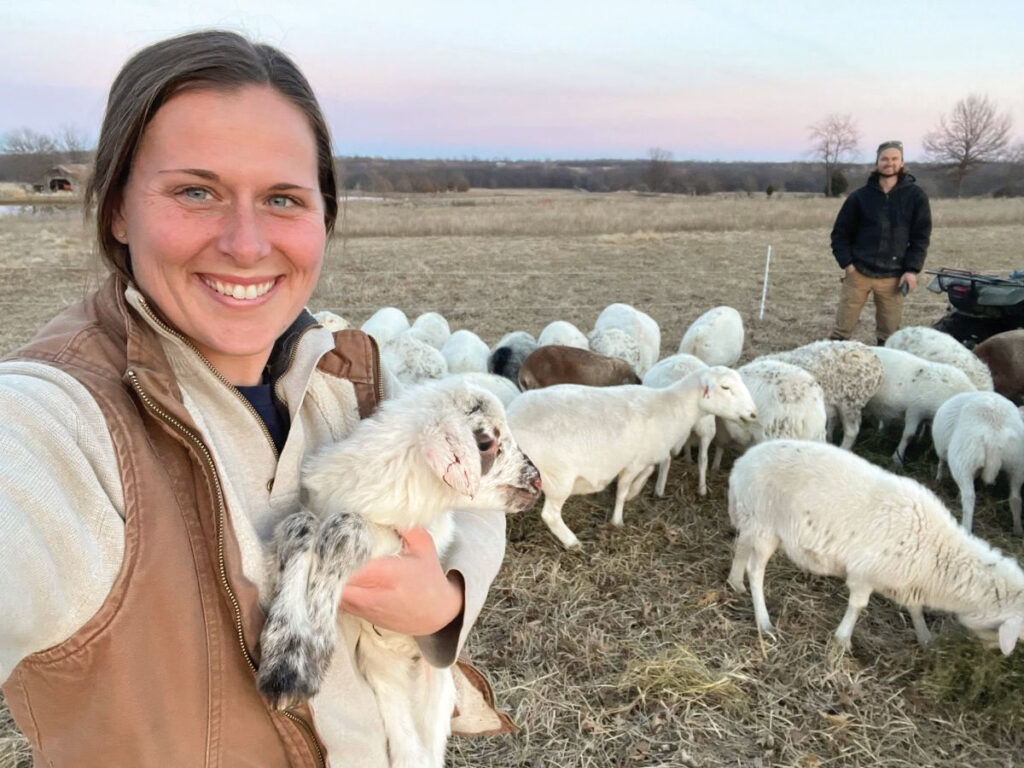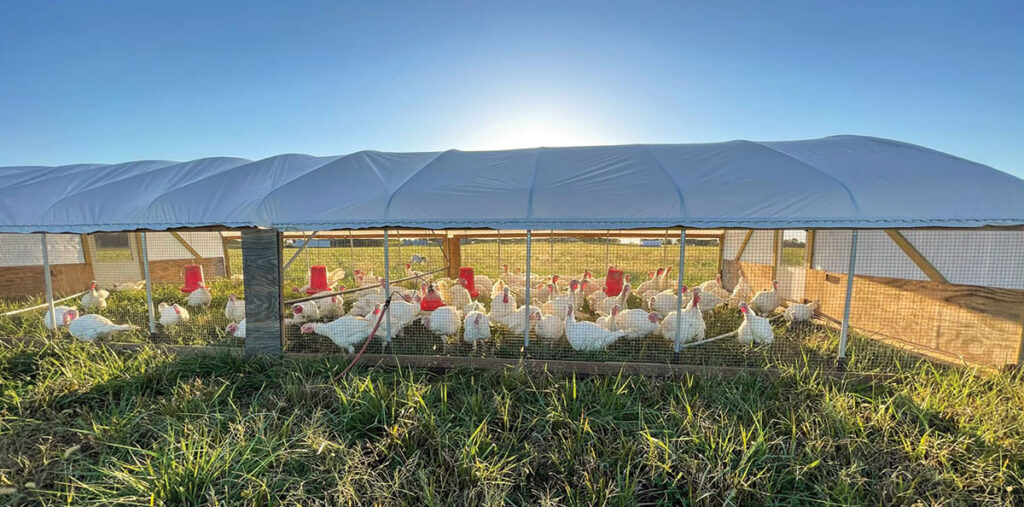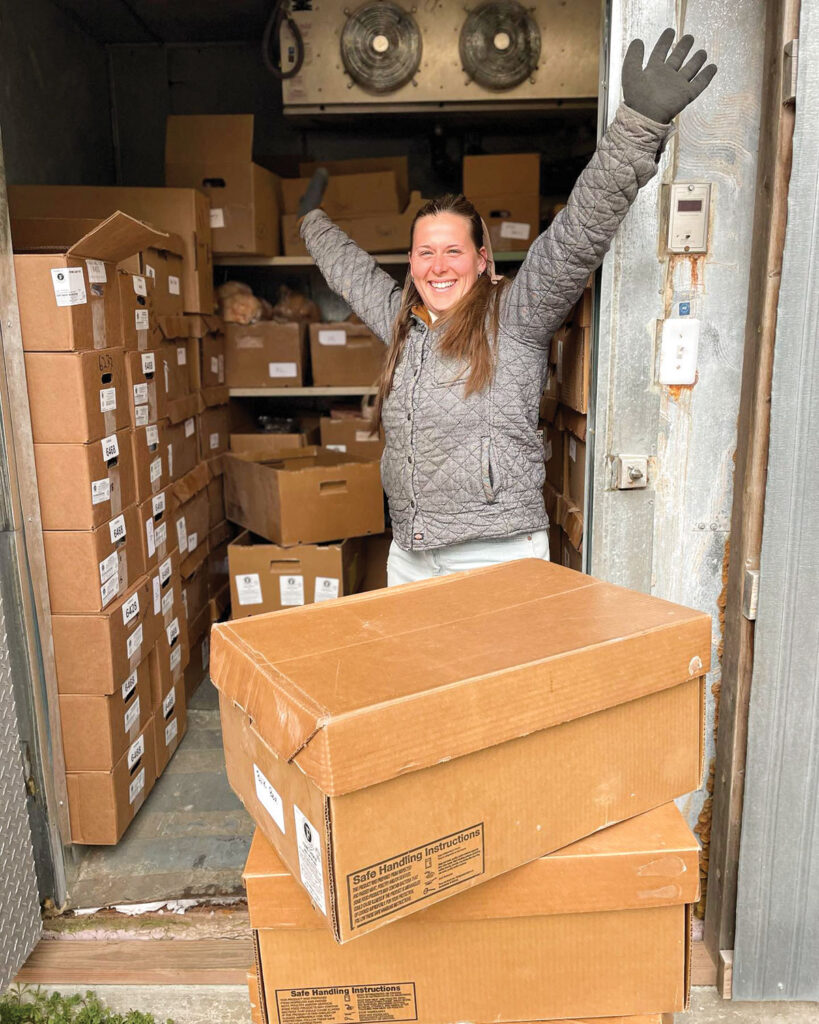
Gabe and Katie Farrar select animals and production methods to improve their family farm
ADRIAN, MO. – Gabe Farrar could have been the generation to leave the family farm behind. Still, the Bates County, Mo., native not only stayed on the farm, he diversified it, became a full-time farmer and learned how his farming practices could replenish the soil, not diminish it.
Today, Gabe and his wife Katie operate Farrar Family Farm in Adrian, Mo., offering farm-fresh meats directly to customers.
Gabe and Katie purchased their 400-acre farm from his parents and left their jobs in 2016. They now offer grass-finished beef and lamb, and pastured pork, chicken and turkey.
“We want to build diversity in the farm for economic reasons and production,” Gabe said. “In some seasons, one might not do very well, but the others will, and it helps the soil get a diversity of nutrients.”
The Farrars take a natural approach to agriculture, choosing to raise all of their animals in a forage- and pasture-based manner.
“We’re trying to do things the natural way, the old way,” Gabe said. “Before World War II, you didn’t have all of the chemicals and antibiotics available. They could produce good, highly-nutritious food and not deplete their soil. They had to treat the soil well year after year, so we’re taking a modern approach to that, using low inputs and higher time management, and treating the soil as our number one coworker.”
“Some say we’re livestock farmers, but we’re grass farmers because without the grass and the soil, the rest wouldn’t happen,” Katie said. “We do all we can to focus on grass and soil health, and the rest of it falls into place when that’s taken care of.”
Cattle graze about 160 acres of the farm through a management-intensive grazing system. The size of the paddocks grazed depends on the time of year and the amount of grass available.
“We have seven permanent paddocks, but we subdivide those and move every day,” Gabe explained.
The couple is working with the Natural Resource Conservation Service through the EQIP program to turn wooded areas into grazable pastures through a grant to aid in the building of fences and water sources.
Gabe and Katie had a lot of work to do to get the land and grass ready for livestock.
“When my parents bought this farm 15, 16 years ago, a lot of it was in CRP (Conservation Reserve Program), and it was mismanaged,” Gabe explained. “It was overgrown, and we started from scratch on a lot of it. There was a lot of mowing to get weeds under control. In a couple of paddocks, we kind of let nature take its course and tried to manage it with animals and mowing.
“In others, we had a lot of problems with fescue toxicity with the cattle we had at the time. We disked some of those paddocks up and reseeded with endophyte-free fescue and some other blends, like a seven-way blend of cool season grasses, to get some diversity and time and slowly get some legumes in there. Our approach now is managing it well and doing things that let it grow.”
Issues with the toxic fescue caused the couple to move toward the South Poll breed.
“We learned a lot through that transition,” Katie said. “We started with black Angus, and we were seeing they weren’t performing well with the basic methods, and moved to breeds that worked better on a grass-based system. We have a mix and match of breeds, but we got rid of quite a few that needed grain finishing or a lot more babying.”
They moved away from a cow/calf operation two or three years ago because of the demand for their grass-finished beef. They average about 80 stocker/feeder calves sourced from South Poll breeders who also follow a grass-only methodology.
“They transition really well,” Katie said. “We found that they don’t transition well if they don’t come from a similar approach.”
Calves come to the Farrar Family Farm after weaning, weighing 550 to 650 pounds, and will remain there for 16 to 18 months. They are currently processing 40 to 50 calves a year.
Calves receive salt, minerals and trace minerals, kelp, garlic and other supplements, but no grain.
Farrar Family Farm broilers are also raised on pasture.

“We only raise meat birds, so we pick one pasture a year and isolate those birds to that pasture,” Gabe explained. “They are raised in a mobile coop, which is like a greenhouse on skids. It will move about 30 feet daily.”
They have multiple batches of the Cornish-cross meat birds each year, so the entire selected pasture benefits from the chicken manure.
“It fertilizes itself in a season,” Katie said. “The cattle also move through that pasture. We’re not bringing in litter from another source or running a tractor over that pasture. It’s nice because we bring the chicks in, and everything from their gut is used to our farm’s microbiome, and we’re not bringing in any chemicals and medications from their poop; they are just regular old chickens.”
The 7,000 chickens the couple raise annually receive a free-choice non-GMO feed.
“They can eat that or forage whatever they pick,” Katie said.
“The cattle keep everything mowed, and the chickens provide nutrients and scratch the soil,” Gabe added.
Gabe and Katie also raise and process about 250 turkeys each year.
“We have our first batch (of the year) here, and those will be butchered in July for things like deli turkey, ground turkey, and all the different cuts, like breasts and thighs,” Katie explained. “The second batch will come in the summer and be processed for our Thanksgiving whole turkeys. They take longer to raise than the chickens, so we only do two batches. We raise them the same as we do the chickens – same structure and pasture – they just move along with them.”
Katie added the demand is high for the birds – both chicken and turkey – and they have increased production several times.

“We’re finally to the point where we might have to hold at a certain number,” she said. “With just the two of us and occasional help from family, that keeps us going – a lot.”
A mix of haired sheep, mostly Katahdin, Dorper, St. Croix, Romanov, came to the operation for natural weed control and to appeal to a new customer base.
“You can raise more pounds per acre,” Gabe said. “They rotate, just like the cows, and we would like to eventually merge them. We are still investigating that, and we will have to update some fencing to do it. Once it’s fully integrated, we are also looking at adding some goats to hit that even harder.”
Gabe and Katie moved from buying feeder ram lambs to get their “feet wet” in sheep production to raising lambs from their flock of ewes, which consists of about 55 ewes, with hopes of increasing to about 150 once the sheep graze with their cattle.
“This past year, we bought some older ewes that were bred and some younger ewe lambs,” Gabe said. “We just finished lambing our older ewes and are getting ready to breed our younger ewes for year-round production and maintaining that flock.”
“People think of mutton when it comes to lamb,” Katie said. “We’ve had some customers say we might have accidentally given them ground beef because our lamb is so mild in flavor.”
Gabe added they have found the sheep manure, as a fertilizer, to be higher in nutrients than chicken litter.
Like other livestock at the Farrar Family Farm, the pigs have a dual purpose.
Pigs are raised in a designated wooded area of the farm that needs improvement. They use the pigs to clear out underbrush and remove unwanted species, such as blackberries and poison ivy.
“We’ve been running pigs in one area for about four years now and instead of daily moving, they get about two weeks in a paddock to give them time to displace things. It’s all balanced on that disturbance and rest method,” Gabe said. “With the cows, chickens and sheep, you want a quick disturbance and a long rest period. The pigs are the opposite in that we want more disturbance because the goal is for them to till up that soil, getting out all of the poison ivy, rosebushes, blackberries, and other things. Then we can go back in and reclaim it.”
The pigs are brought to the farm as feeders sourced from a local breeder. In addition to foraging, they receive a free-choice non-GMO feed and are processed at about 8 months of age. Gabe and Katie estimate that they will process 150 pigs, or more, this year.
“For our size, it’s more economical for us to do feeders,” Gabe said. “When you crunch the numbers, having to keep breeding stock year-round and farrowing care, you need to butcher 200 or more just to justify the extra enterprise.”
Because of their proximity to the Kansas City, Mo., area, Gabe and Katie feel they have an extensive customer base, which includes online sales and farmers markets.
“We started with just beef, then added chicken and got to make that connection with customers,” Katie said. “Meeting the person who raises their food seals the deal with them and makes them more confident about what they are ordering. We have gotten to know so many families; then they share with their neighbor at a barbecue that they got these hot dogs through the Farrars.”







